This post is part of a 4-part series on the rhythmic style of J Dilla.
Part I: (History) · Part II (Theory) · Part III (Grooves) · Part IV (Application)
In this post I want to take a look at some transcriptions of Dilla feels found in the wild to break down what they’re doing.
The transcription methodology for these tunes was to pick a four bar section where the beat is clearly audible and align it to a beat grid in Ableton. I then recreated the grooves on separate tracks by looking at the waveform to determine where individual hits occurred. When the waveform was unclear, I placed a sample in the approximate location and then adjusted it until it no longer made an audible flam against the track. For some of the songs with sampled drums, I isolated the samples and aligned them via phase cancellation.
This post includes screenshots of the Ableton live sessions and standard notation for each tune. For the standard notation, I focused on creating intuitive and easily digestible summaries of the grooves rather than notate them literally. I experimented with a couple different approaches for notating subdivisions and microtime including written descriptions, approximating to the nearest subdivision, and using special symbols to mark when notes fall behind/ahead of the written beat.
J Dilla – Kamaal
I chose this tune to start because it shows off a lot of the classic Dilla elements. It has a really subtle, unquantized swing to it, partway in between straight and septuplet swing. The straight 8th notes in the kick on beat one contrasts against the slightly swung hi-hat note to create a characteristic Dilla flam. The snare and hi-hat are also slightly rushed on the backbeat (notated with tied grace notes), another Dilla trademark for creating that lop-sided, lilting feel.
J Dilla – Colors of You
This tune has another classic Dilla element: kick stutters. In the last post I discussed using kick stutters on the septuplet subdivision. This tune uses faster stutters on the 32nd note division.
The hi-hat is playing unquantized, slightly swung 8th notes. I didn’t include a swing ratio on this because it is much looser and moves around between nearly straight and nearly septuplet.
The beat gets a little wonky in measure 3 where the kick starts playing weirder subdivisions.
D’Angelo – Left and Right
This tune comes from D’Angelo’s landmark neo-soul album Voodoo (2001), recorded during The Soulquarians period at Electric Ladyland studios (1996-2002). D’Angelo was big on off-the-grid, “drunk” time feels and this record has a lot of classic grooves.
Erykah Badu – Fall in Love (Your Funeral)
Another Soulquarian, Erykah Badu was a close friend and collaborator of J Dilla. I was actually turned on to this tune by Slynk in his wonderful video on quintuplet swing. The idea here is that this is like a straight 8th beat, but the hi-hat/synth were shifted back a bit so the off-beat falls on the quintuplet swing and the on-beat just sounds really late, creating this kind of messed up, sloshy sounding time feel.
Idealism – How Many Stars Are There
This tune isn’t directly related to Dilla, but it has a really cool beat. There are a lot of mixed subdivisions, so I decided to break out all the parts into their own lines for readability.
There are two hi-hat samples, one of which is playing a pretty steady near-septuplet swing. The other is doing its own thing, interjecting notes that don’t conform to any meaningful subdivision. It also has some straight 8ths thrown in which make really nice flams against the septuplet swing.
Similarly to Dilla’s “Kamaal”, the snare here rushes beat 2 slightly (in this case exactly a 64th note), and creates a flam against the hi-hat. On beat 4 the hi-hat and snare hit together on the beat.
This is probably the most complicated of all the beats I transcribed. In addition to the mixed subdivisions and out-of-time notes, the entire thing drifts slightly back on the beat throughout the four bar phrase. The amount of drift is small, but it has the cool effect of making the later bars swing a little bit harder than the earlier bars. At the start of bar 1, the hi-hat is playing very slightly ahead of a perfect septuplet swing. By bar four, it’s behind the septuplet, nearly half-way to a quintuplet swing. I think this does a lot for the loopability the beat. It’s like a cycle of tension and release where rhythmic dissonance is steadily introduced as the drums drag the tempo, and then that is resolved when they snap back into place on the repeat. It’s also interesting to listen to because the rhythmic relationship between drums and piano isn’t quite the same for any two bars in a row.
This drift almost sounds like it was a sampled loop that wasn’t quite the right tempo for this tune, and instead of time correcting it, they just chopped the end off to make it fit.
Kendrick Lamar – How Much A Dollar Cost
An example from modern hip-hop. The swing is in between triplet and quintuplet and happens to fall almost exactly a 32nd note after the straight 8th offbeat. This gives a swing ratio of roughly 5:3 or 62.5%. It’s also very close to the golden ratio (61.8%). It’s a really interesting feel, it combines the rolling quality of a slow triplet swing with some of the angularity of a quintuplet swing. I’d never considered using this subdivision before, but it sounds really hip so I’m glad I transcribed this.
Chris Dave And The Drumhedz – Destiny N Stereo
Chris Dave is one of the drummers largely credited with introducing Dilla to the world of modern jazz through his hip-hop/jazz crossover work with The Robert Glasper Experiment. This tune is from his later group Chris Dave and The Drumhedz, an experimental hip-hop/neo-soul/jazz collaboration. It features one of his signature polysubdivided grooves that has a straight 8th hi-hat line against an accented triplet swing note.
For this chart I tried using custom articulations (<< and >>) to mark where Chris Dave is playing notes ahead of or behind the beat by amounts less than a meaningful subdivision. I also broke the hi-hat out into its own staff for readability with the polysubdivided rhythms.
In addition to the main groove, I also transcribed one of Chris Dave’s signature semi-out-of-time fills which roughly corresponded to a septuplet rhythm.
In the next part I’ll try writing my own hip-hop beat incorporating some of these concepts.
I am a Columbus-based drummer, composer, and video artist. If you liked this post, consider checking out some of my other work!























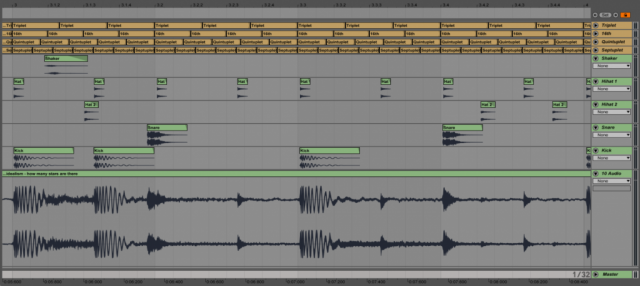


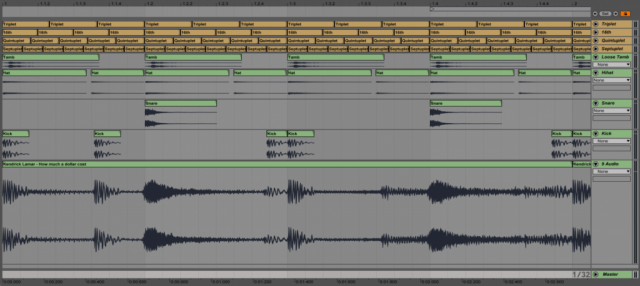

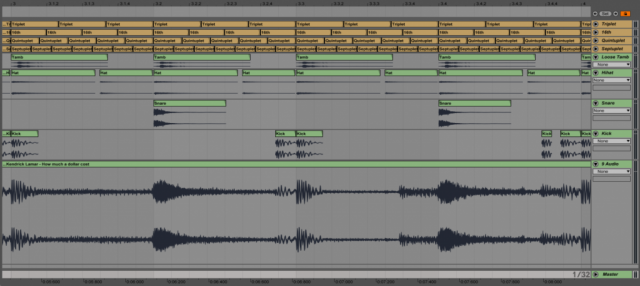
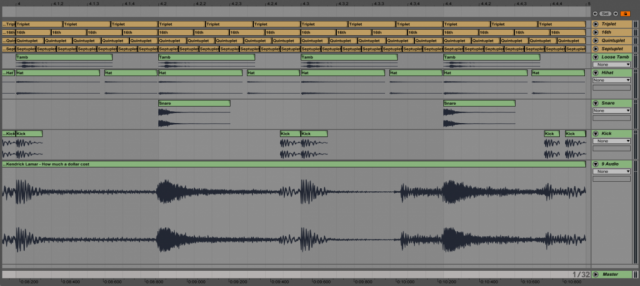





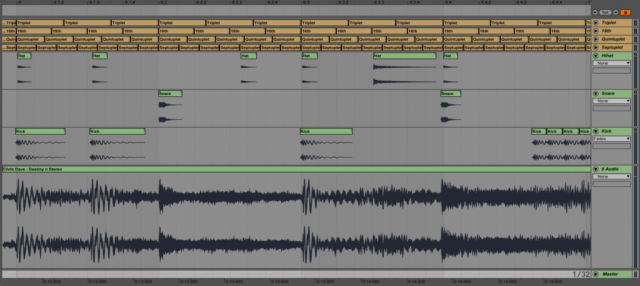


Absolutely beautiful .. made many concepts easier to understand as im quite a beginner to music theory but i cannot thank you enough for an outstanding analysis .. really comprehensive .. great work
I had a question about shakers in afro-pop or modern afro-fusion as they sometimes like to call it
taking a song like (Gbona-Burna Boy) for example ..
i think the shakers and most of the song as actually swung to a septuplet swing i think but being over a clave gives it a completely different flavor.. do you think it’s a septuplet swing that these african shaker loops use or is it something with less constraints and a abit more flexible you reckon?
Thank you! That song sounds like it’s close to a triplet swing to me, with maybe some of the notes a little straighter. If you want to find the exact groove, I’d recommend cutting out 1-2 measures in a DAW and rebuilding the drums by looking at the transients in the waveform!